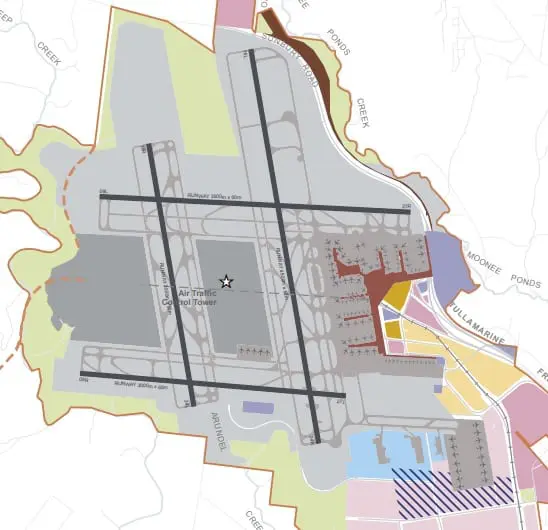_Planning ‘controls’ and Melbourne Airport
Every five years, the Melbourne Airport masterplan is reviewed and, if necessary, revised to protect the operation of the airport as well as safeguard plans for its future expansion however, with the exception of the Schedules 1 (MAEO1) and 2 (MAEO2) to the Melbourne Airport Environs Overlay, a majority of the planning ‘controls’ and issues raised in the masterplan sit outside the planning system.
MAEO1 and MAEO2 are based on the 25 and 20 Australian Noise Exposure Forecast (ANEF) contours respectively and are well established in managing the more intensive exposure to aircraft noise by limiting the development potential of land under those overlays. With it being well documented that the Melbourne Airport has plans to add both additional north-south and east-west runways in a ‘hash tag’ arrangement, to the existing runways, the coverage of MAEO1 and MAEO2 may well be varied.

In addition to these overlays, both the 2013 and 2018 iterations of the Melbourne Airport Masterplan included an ‘N-above’ contour framework to complement MAEO1 and MAEO2 by identifying broader areas that are susceptible to noise exposure albeit at a reduced intensity. Despite this information being available for some time, the ‘N-above’ contours have sat largely outside the planning system and, unlike the MAEO1 or the MAEO2, there are no noise attenuation requirements affecting the construction of a building, which we understand has led to increased noise complaints.
Similarly, under the Airports Act 1996 and the Airports (Protection of Airspace) Regulations 1996, a responsible authority is required to review planning permit applications and, if any development is proposed to penetrate the prescribed airspace (known as a controlled activity), it must be referred to the Melbourne Airport. With the exception of extremely tall buildings, structures that are proposed to penetrate the prescribed airspace are generally allowable provided they are clearly visible to incoming / outgoing pilots / planes.
In addition to the Planning Scheme, Planning Act and Regulations as well as other relevant planning documents and considerations, it is not surprising that a responsible authority planning officer is not always familiar / up to date with the requirements of the Airports Act 1996 and the Airports (Protection of Airspace) Regulations 1996. As a result, this has resulted in planning permits being issued for development without approval for a controlled activity being sought from the Melbourne Airport operator.
All of this has led to the establishment of the Melbourne Airport Environs Safeguarding Standing Advisory Committee (MAESSAC), which has been set the task of reviewing early in the year the above planning ‘controls’.
As part of this review, we hope that the MAESSAC whilst recognising the need to protect the existing operation of Melbourne Airport, weighs this up against appropriate other relevant strategic considerations such as the need to accommodate housing growth at increased densities where appropriate noise attenuation can be provided.
This provides also the opportunity to closely examine MAEO1 and MAEO2 in order to establish whether certain types of development within these overlays are being stifled unreasonably.
Lastly, we welcome the work to be carried out by the MAESSAC and hope that it will lead to a more transparent / inclusive planning system.
